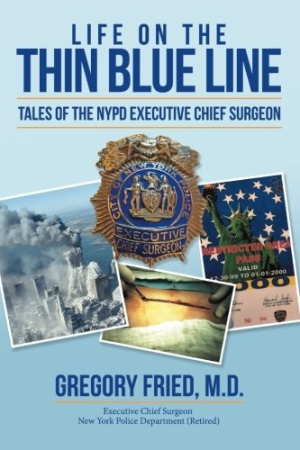Life on the Thin Blue Line
Tales of the NYPD Executive Chief Surgeon
Fried’s firsthand account of acting as a 9/11 first responder is gripping.
Gregory Fried’s memoir, Life on the Thin Blue Line, recounts the author’s time as the executive police surgeon for the New York City Police Department.
The book imparts information about medicine, politics, power, and the frustrations of bumping heads with a bureaucracy insistent upon always having done things a particular way. Through many episodes, the narrative tracks Fried’s progression from an uneventful education at Cornell into work as a hotshot surgeon for the NYPD with innovative ideas.
Impressive accomplishments are shared with a boastful tone. An acerbic wit also peppers the narrative, especially when the author describes the system’s unwillingness to shed tradition and embrace change.
Detailed scenes show Fried traversing hospital and police department duties. He exhibits impressive tenacity and a drive to excel professionally, and this determination culminates in his role as a first responder on 9/11.
Fried’s firsthand account captures the moments after both planes hit the World Trade Center. The South Tower collapsed and rubble buried him. He explains his strange physical, mental, and emotional response as he lingered in a kind of limbo and then faced a long recovery.
His unique perspective adds a specific human element to an already notable story. With his experiences as both a surgeon and a patient, Fried is able to narrate injury and healing from both sides of the hospital bed, making for a sympathetic and informed story.
Fried has accomplished and experienced much that is interesting, and he is a heroic and compelling narrator. Illuminating details about the professional worlds of politics and medicine provide insider’s knowledge, casting Fried as a larger-than-life personality. He is relatable, even though he has lived an extraordinary life. He shares these events with an eagerness and sincerity that is endearing.
The book is loosely structured and organized. Tangential asides and redundant episodes become a distraction. At times, peripheral players and events are reintroduced as if for the first time, muddying the book’s timeline. Writing comes across as unpolished when the narrative tries to fit in too many details, such as different types of hernias and the difficulties of scheduling surgery on a certain day.
Many episodes go beyond the text’s presented focus on acting as a police surgeon, including early childhood accounts and later domestic troubles that disrupt the more compelling events.
Life on the Thin Blue Line is a heroic and uplifting story and a model tale of professional success that shows how hard work, determination, and a little luck permit talented individuals to accomplish much.
Reviewed by
Philip J. Kowalski
Disclosure: This article is not an endorsement, but a review. The publisher of this book provided free copies of the book and paid a small fee to have their book reviewed by a professional reviewer. Foreword Reviews and Clarion Reviews make no guarantee that the publisher will receive a positive review. Foreword Magazine, Inc. is disclosing this in accordance with the Federal Trade Commission’s 16 CFR, Part 255.

